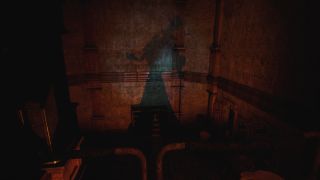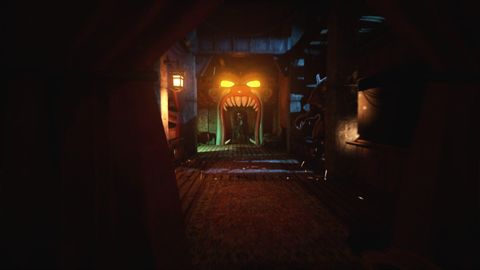
When a game starts off with the disclaimer of being based on a true story, or it warns of content that may be distressing to viewers, I know I tend to roll my eyes and not worry myself about it. For one thing, I am an (almost) 30-year-old woman, and for someone my age with a fair amount of life experience I like to think there isn't much that will disturb me.

While The Park isn't based on a true story, it does come with a distress warning which comes off as being mostly lighthearted. I was expecting something akin to the first person survival horror games Outlast, or Slender: The Arrival. What I got instead was something that actually shook me emotionally for days after I'd finished the game.
The Park is a short first person psychological horror experience, set in an after-hours amusement park hiding a dark secret. Rather than focusing on fighting and action, the game is played out through exploration and storyline.
Welcome to the house of fun
The Park

The Park is about a young mother, Lorraine, searching for her son, Callum, who ran back into the park once it closed.
It is best played with headphones and in the dark, as it helps you become more immersed in the game. The headphones will also aid you with directional audio cues; playing as Lorraine, when you call to Callum, he will respond and the stereo headphones pan the audio between both channels to give you a sense of direction.
Walking around the park, you find scraps of paper and newspaper clippings which detail the history of the owner and his descent into depravity. There are also allusions to staff members expressing discomfort at working with people who won't take off their mascot costumes, and seem to be watching them all the time.
The game employs the use of eerie atmospheres, twisted slow music and jump scares to create tension, which I found rather mild. Perhaps this was my hardened attitude towards survival horror games, I had built my nerve to expect scares at likely moments, such as a suspiciously peaceful break in tension. Sometimes, however, it's not even a jump scare that will make you feel twisted, it could be something brought to your attention that you know wasn't there a moment ago.
The graphics are nice and clean, with only a questionable texture layer on Lorraine that makes her look like she applied her makeup in the dark while driving on a bumpy road. If you call Callum, it also shows any nearby points of interests with an effect that distorts reality. I like this because you don't have to use it. The game is pretty linear, and you will make it through The Park without calling once if you choose. It also means you'll be exploring more and discovering the wider sinister story of the park itself.
The art of misdirection
Smoke and Mirrors

Within mere minutes of entering the Park, Lorraine's calls go from authoritative to anxious, and as the story progresses we learn that she suffers from depression. She makes recollections about her life, her son and her illness, which flip from being upbeat to downright spiteful and back as she progresses on her quest.
As you walk around, you can also enter the rides. During the respite from frantically searching for her son, Lorraine recalls a memory to herself, the rides malfunction in some way, but you see nothing but a shadowy shape manning the control box.
Lorraine, while declared healthy enough to have custody of her son if she continues to take her medication, Zolift (an obvious play on the brand Zoloft), her mental health takes a disturbing and rapid decline while searching for Callum. This isn't helped by being seemingly stalked by the park mascot, Chipmunk Chad. The park's owner has clearly been doing sinister things.
As Lorraine descends into her own personal hell, we begin to wonder who might actually be responsible for Callum's disappearance: the creepy Chad who has stalked you in darkened rides, or the child's own mother, who is descending into madness.
During moments when Lorraine is experiencing intense anxiety or fear, the controller vibrates violently in time with her heart rate. The controller vibration is a way of expressing the effects of anxiety physically. As she calms down, the vibrations decrease in their severity, eventually fading. It's difficult, if not impossible to control while these episodes occur, which is much like how anxiety can freeze people to the spot in stressful situations.
While I found the horror elements to be pretty mild, I was more disturbed by the visceral portrayal of Lorraine's depression. Having depression myself, I was shocked at such a visually horrific representation of my own thorn-in-my-side. I actually did get distressed, and I began descending into my own personal dark place, as Lorraine's began to reach its somewhat confused climax. The game affected me much more than I ever thought it would.
The Bogeyman, the entity that may have kidnapped Callum, is in my opinion, clearly an artist's depiction of a physical manifestation of depression. If depression was a person, what would it look like? If you took a mix of Tim Burton's Mad Hatter, Jack Skellington, and Beetlejuice, and sprinkled a bit more horror on it, you might be close.
As a parent, the subject of losing a child, or your child dying, is one many people don't dare talk about. As though merely stringing the words together and carelessly tumbling them from your lips could cause instantaneous mass child-death. It's taboo. So pairing these two weaknesses of mine together in such a way cut me very deeply.
The ambiguity as to whether she killed Callum or not is also something that didn't sit with me very well. I felt as though it portrayed people with depression to be borderline murderous, and unsuitable to be around children. Lorraine refers to herself often as a bad mother, which is a label nobody wants at the best of times, but having depression doesn't immediately make you a bad parent.
On one hand, I loved the game for showing such a brutal display of struggle with inner demons, and on the other, I felt like it wildly misrepresented depression. While there are mental illnesses that come with terrifying visual and auditory hallucinations, Lorraine comes off as having the worst drug trip ever.
Once the credits had rolled, I went out into the kitchen so my boyfriend didn't see me cry my eyes out. It was so open about issues that are very painful for me on a personal level. On social media later that day, I laughed at my silliness for crying at a game, only to get a private message from someone saying that they too reacted the same way to The Park.
Come again soon...
Summary

The Park threw me a curveball I never expected in its portrayal of severe mental illnesses and its ability to warp and distort reality. I really enjoyed the game as a whole, short as it is, but I feel my experiences with depression, and the fact I am a parent, will make me see something a little different to other players as maybe neither of these things are relatable to you. But the story is well told (when you can read the font), and without falling into a bad pun territory, it really is a ride I won't forget for a while.
Pros:
- Thought-provoking subject matter
- Well told story
- Engaging and simple to play
Cons:
- Fonts are too small to comfortably read
- Subject matters may cause upset in some players
- Predictable scare moments
Lauren Relph is a games writer, focusing on Xbox. She doesn't like piña coladas but loves getting caught in the rain. Follow her on Twitter!

